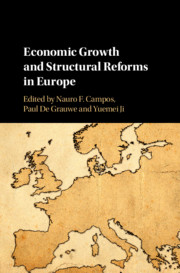Book contents
- Economic Growth and Structural Reforms in Europe
- Economic Growth and Structural Reforms in Europe
- Copyright page
- Contents
- Figures
- Tables
- Contributors
- Introduction
- Part I Economic Growth and Structural Reforms in Europe
- Part II Macroeconomic Implications of Reforms
- 4 Heterogeneous Market Regulation and Divergence in a Currency Union
- 5 Macroeconomic Imbalances in the Euro Area
- 6 Financial Crises and Liberalization
- 7 Structural Reforms and Fiscal Sustainability
- 8 Transitions in the EU Labour Market before and after the Crisis
- 9 On the Complementarity between Labour Market Regulation and Tax Reforms in the European Union
- Part III Case Studies
- Conclusions
- Index
- References
5 - Macroeconomic Imbalances in the Euro Area
Can They Be Managed?
from Part II - Macroeconomic Implications of Reforms
Published online by Cambridge University Press: 31 March 2020
- Economic Growth and Structural Reforms in Europe
- Economic Growth and Structural Reforms in Europe
- Copyright page
- Contents
- Figures
- Tables
- Contributors
- Introduction
- Part I Economic Growth and Structural Reforms in Europe
- Part II Macroeconomic Implications of Reforms
- 4 Heterogeneous Market Regulation and Divergence in a Currency Union
- 5 Macroeconomic Imbalances in the Euro Area
- 6 Financial Crises and Liberalization
- 7 Structural Reforms and Fiscal Sustainability
- 8 Transitions in the EU Labour Market before and after the Crisis
- 9 On the Complementarity between Labour Market Regulation and Tax Reforms in the European Union
- Part III Case Studies
- Conclusions
- Index
- References
Summary
Over recent years, a consensus has emerged that 'policy failures that allowed imbalances to get so large' were probably the main root cause of the Euro area crisis.Reflecting this, the new Euro area governance arrangements include a Macroeconomic Imbalances Procedure (MIP) that seeks to identify and take corrective action against emerging imbalances.This chapter uses a Bayesian structural VAR model to assess the feasibility of managing macroeconomic imbalances in the Euro area using four macroeconomic policy tools:fiscal policy, macroprudential policy, product market structural reforms and labour market reforms.Consistent with the emerging literature, it finds that managing macroeconomic imbalances is likely to be difficult.However, it raises the tantalising prospect that a combination of eliminating structural rigidities before macroeconomic imbalances arise plus using macroprudential policy to manage emerging macroeconomic imbalances could be effective.
Keywords
- Type
- Chapter
- Information
- Economic Growth and Structural Reforms in Europe , pp. 141 - 176Publisher: Cambridge University PressPrint publication year: 2020



